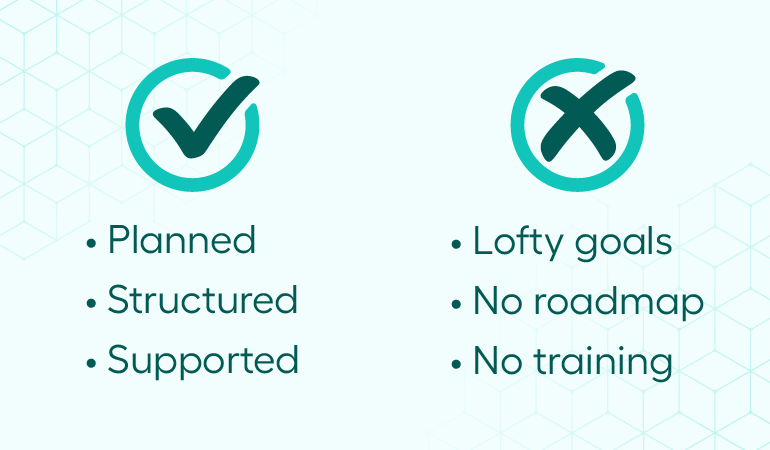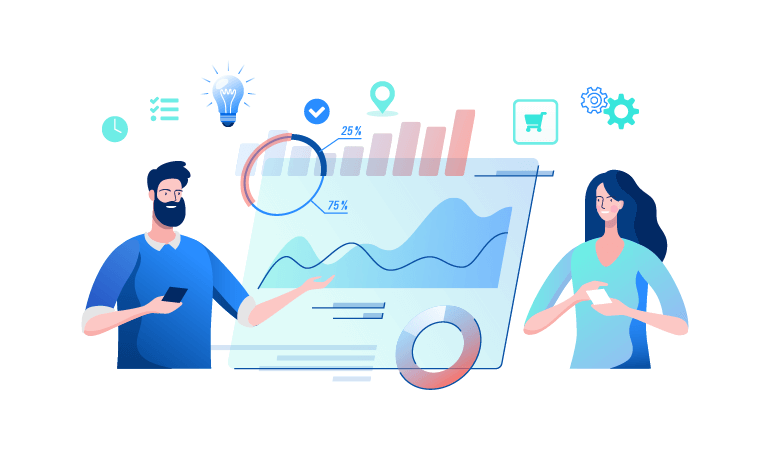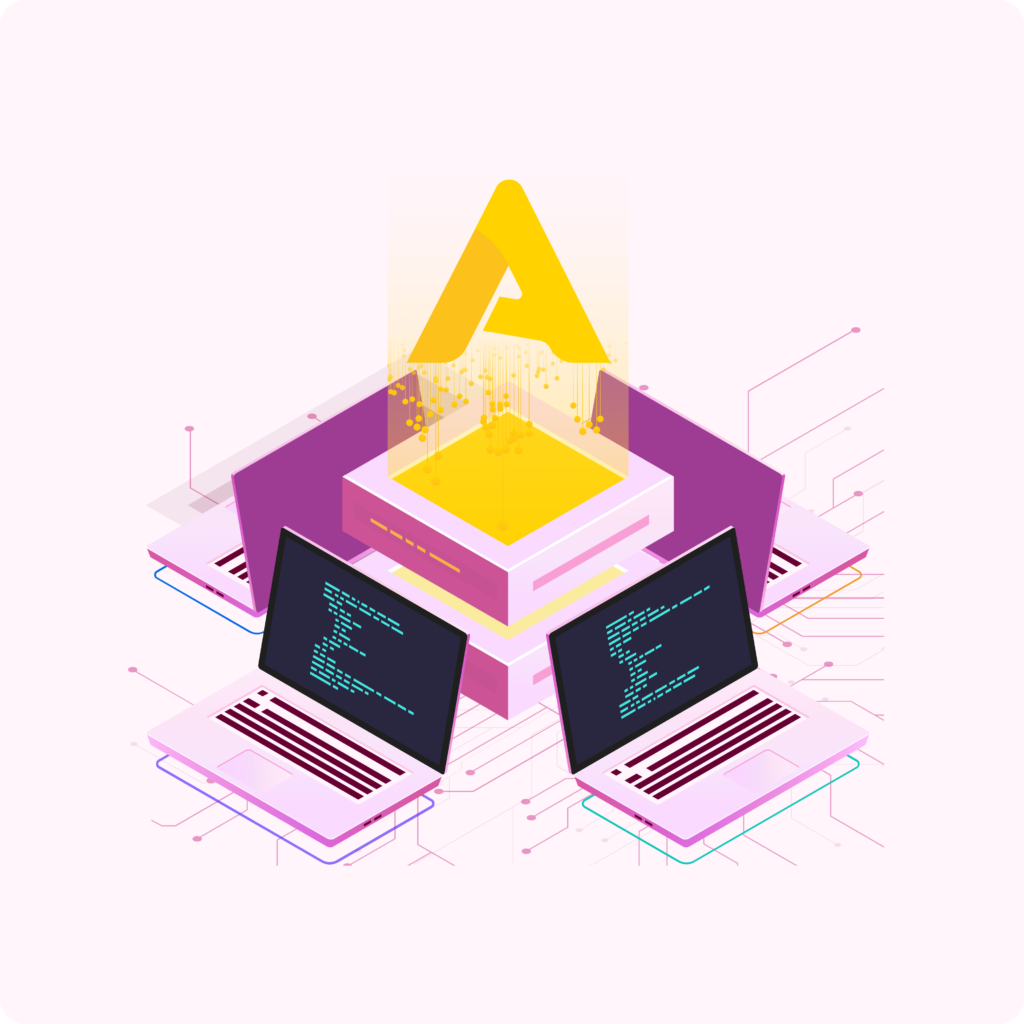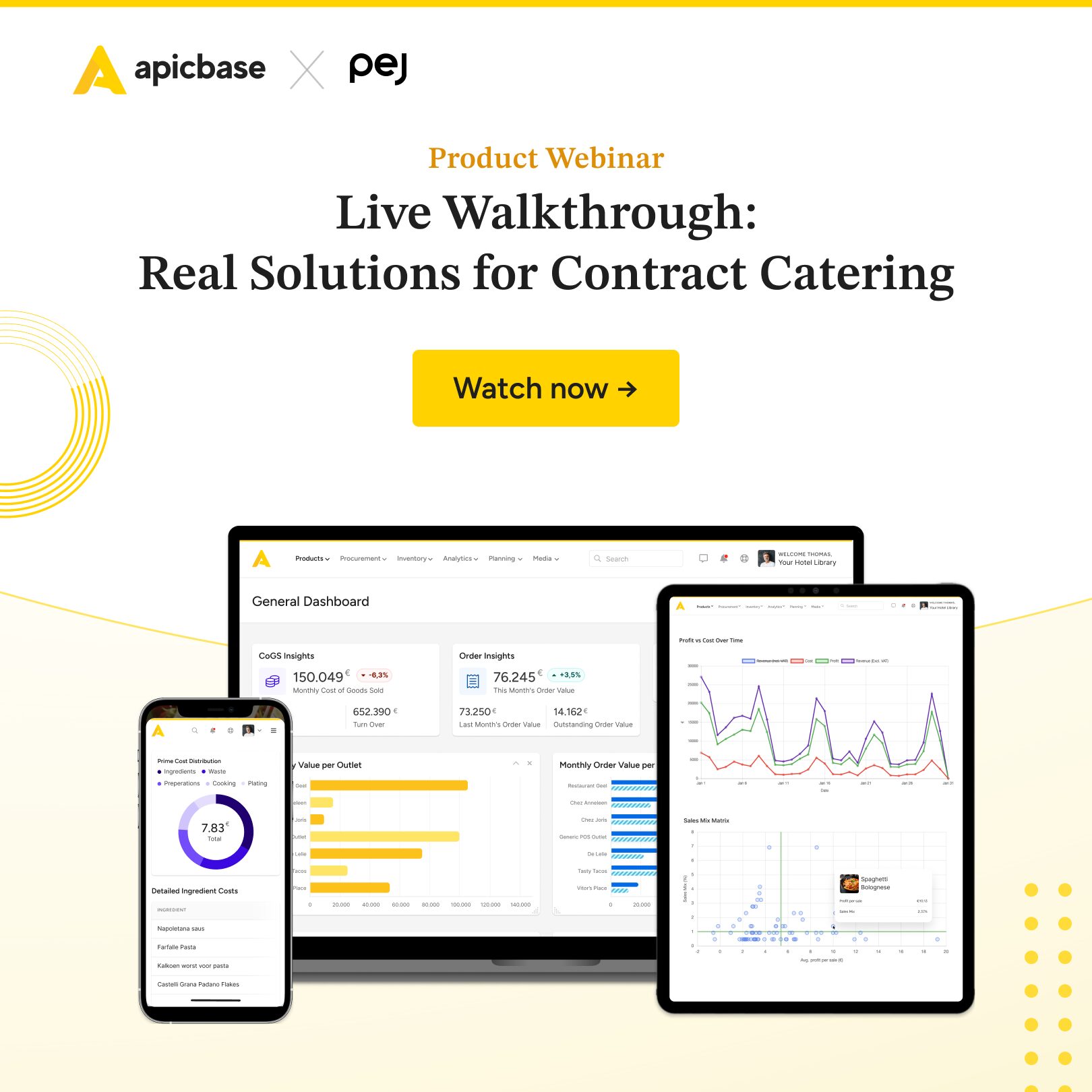The #1 reason why businesses decide to pursue digital transformation (DT) is how much of an impact it has on the operational excellence of (hotel)restaurants, catering businesses and food and beverage management.
Steered correctly, successfully digitising your food operation results in:
- streamlined & automated processes
- accurate business-building insights
- a 360-degree view of the entire operation
Let’s recap the above article real quick:
What is the digital transformation of the restaurant industry?
Digital transformation in the restaurant industry means drawing accurate, actionable, and timely insights from integrated technology solutions. In a digitally transformed F&B environment, for example, POS, menu management, payroll, and other processes & systems interconnect and ‘talk’.
There are no data silos that are hiding valuable data — and there is no data overwhelm. This way, tech solutions can sift through millions of data points to make strategic business suggestions for executives at every level.
If you are the head of F&B in a restaurant chain, the corporate head chef of a hotel brand, or the supply chain manager of a large catering service, it’s only natural that you want to tap into the benefits of integrated technology. And that you want it done yesterday.
The only issue is…
Digitalisation efforts are still happening a bit haphazardly in most F&B organisations.
They are mostly department-led ad hoc projects. They’re not discussed externally [which leads to incompatible technology and systems]. And so they’re not connected by a common-goal thread that would be beneficial to the entire organisation.
If you’re having the same problems, you’re in the right place.
In this blueprint, I’ll show you three things that you need to focus on today to get that transformation ball rolling and to give your digitalisation initiative a rock-solid foundation:
- The organisational setup and mindset that will make your job easier;
- What to look for when deciding on your FoH and BoH tech stacks;
- Why company culture plays a critical role in your success (and how to adjust yours).
Ready to dig deep into the three steps that will help you activate digital transformation in your restaurant, hotel chain, or catering business?
Let’s go.

Get the Ultimate Guide to Digital Transformation in the Restaurant & Foodservice Industry
You’ll get a top-level overview of how AI can help you transform your F&B operation.
1. Set Your F&B Digital Transformation Initiative Up for Success
Unsuccessful digital transformations all look the same:
— an organisation sets lofty goals but is unwilling to make bold experimental moves. There’s no rhyme or rhythm to the initiative — no roadmap, no structure, and no training. No one on the team is thinking big, and no one is willing to reshuffle and reshape legacy policies and procedures to spark a real change. So the initiative just fizzles out.
You don’t want to find yourself in this situation.

Successful transformations also share commonalities: a desire to set stretch goals, focus on the right kinds of incremental projects, and a willingness to rewrite the core DNA of an organisation.
More importantly, they are planned, structured, and supported all the way through.
So if you want to join the winning DT teams, here are a few things that will help you set up for success:
- Start with visionary leadership — the core team [and that’s the F&B exec, managers from HR, operations, and finance + a slew of IT experts] behind your DT initiative needs to understand the industry. They need to embrace the trends, and be familiar with the technology. But, more importantly, they need to be able to visualise where your organisation is and where it wants to go. Before starting on anything DT related, answer these questions:
– What do we want to accomplish through digital transformation? Get as specific as possible here — lower food costs… what’s the magical percentage for you? Faster growth… how many new locations per year? Faster time-to-profit for new locations… are we talking three months or six months here? Once you know your goalposts, it becomes easier to prioritise needle-moving digital transformation initiatives and projects.
– What do we need to get to where we want to be? Think in terms of technology and manpower. Do you need to upgrade your tech stacks? What features should you prioritise? What are your competitors using? How about your people — are there any knowledge gaps that you need to fill, either through additional hiring or extra training? Get clear on this as you’re starting out so that you don’t end up in a mid-project scramble [wasting time and spending more money than budgeted].
– What do we already have that we can use? Go outside the F&B department to look for best DT practices. Did your HR department adopt a DT solution? How did they tackle process changes? How about your marketing department — can they maybe offer insights on tech integrations and IT workloads? Ask around — you’ll be surprised to know how much DT know-how you already have in-house. - ‘Sell’ the initiative to your employees — as you’re introducing new technology and new systems, make sure you train your people on how to use them. But — and this is even more important — spend more time on the why behind everything than on the mechanics. You need top-to-bottom buy-in, and you’ll only get it if your people understand what’s happening and what it means for them.
- Remove policy obstacles — don’t let stale policies and procedures hold you back. Reevaluate them at the start of your project, and then every time you catch them impeding progress.
For example, automated F&B procurement gets very clunky when you have three layers of approvals that you need to go through to change a vendor. But when you remove that procedural obstacle [and when you trust data to come up with your best purchasing options], you a) speed things up, and b) end up with significant savings. - Test before major rollouts — and start small. Small DT initiatives are easy to set up, don’t cost much, and you’ll get to see if they pan out pretty quickly. If they don’t, you scrap them and iterate, making changes based on what you’ve learned from previous attempts.
For example, you can pick a single location to test out how good your BoH + HR systems integration is at planning staff rotas. If it turns out that the systems can communicate and churn out quality insights and recommendations, make the project scale-ready. If you’re not happy with the results, at least you’ll find out where the kinks are [and you can think about how to iron them out].
Of course, your mileage here may very well vary. How you set up for your initial DT push will depend on the size of your operation, the level of your digital maturity, and where you are when it comes to the 6 stages of digital transformation (← click right there for a full debrief) Evaluate your situation, and add (or take away) steps as you see fit.
We don’t have to worry about purchasing mistakes anymore. Even when people on the floor don’t have experience in ordering F&B, we know the inventory data in Apicbase is correct and orders automatically go to the right supplier.
Tosca Eggenhuizen
CitizenM Hotels, Product Owner POS and Inventory Management
2. Pick Your FoH & BoH Tech Stacks With Care
Depending on your sizes, you may be currently managing your front and back of house operations with proprietary tech or with legacy point solutions.
In both cases, you’re burdened with a ‘technology debt’.
Your processes are obsolete because of practical limitations; they’re cobbled together and often fall apart, and they are extremely rigid. Small changes mean involving the IT department or hiring outside help. Not an ideal situation if you’re supposed to be a data-driven organisation.
The success of digital transformation in F&B hinges on having the right tech — software that supports your new processes, and vice-versa. Generally, what this means is that you need to start from scratch, figuring out what the ideal outcomes are and then putting the right tech stack together to accomplish them.
Sounds like a tall order?
Probably… but it can be done.
Here are six tips that will help you through the process:
- Ask for recommendations — and ask them from your peers in F&B operations of similar size to yours. They’ll be able to give you the skinny on the solutions they use: what works, what doesn’t, what needs to be jury-rigged and how etc. If you don’t want to go to your direct competitors — go to your vendors [POS people, F&B suppliers, and similar]. They are a great source of information because they talk to everyone in the industry.
- For FoH, start with the customer journey — how can you design the whole process to increase customer satisfaction? Should you add digital menus? Or maybe online table booking? Or a takeout option? Now, think about how delivering this will add more value to your BoH decision-making? If it adds just a bit of value [online bookings = better planning ability = value], consider adding the tech and the needed processes to support it.
- For BoH, go to the extreme nitty-gritty — when it comes to the back of house operations, the devil is in the details. What I mean by this is — the more granular you can get here, the better. You want a tool that a) tackles everything, from bills of materials to vendor management, b) spits out optimisation recommendations, and c) automates time-consuming tasks with accuracy.
- Check out feature rollouts — for every piece of tech you bring aboard, check out what the plans are. You want to make sure that you’re introducing tech that has a nose for an AI-enabled future — ecosystem integrations, IoT integrations, blockchain integrations, added/expanded machine learning & artificial intelligence capabilities, and so on.
- Partner with companies that are listening to their customers — what I mean by this is: try to suss out how any one tech company you’re looking at for a solution handles customer requests. Requests for features or requests for integrations. You’ll want to align with those that pour considerable resources into providing what’s needed instead of what’s profitable. If a small but very needed request for a specific integration keeps getting pushed back in the roadmap, you’re better off giving that solution a wide berth.
- Support implementation with a knowledge library — the first few months of using new systems, new processes and new tech are never a walk in the park. Plan for by having your content team create a resource library [how-to posts, FAQs, video walkthroughs] that will a) serve as a great tool for speeding up onboarding, and b) provide all employees with quick access to answers to their most frequent questions.
FYI Apicbase boasts an extensive online academy with detailed step-by-step video tutorials and ‘how to’-articles. They make onboarding a breeze. Plus, your employees can look things up whenever they want. Even it is just to refresh their memory after a well-deserved vacation.
Get Insider Perspective
If you’re an enterprise-level F&B operation — a large hotel chain, a B2B caterer, or an international restaurant chain — you’re going to love Apicbase.
It’s a one-stop shop for digitalising your back-of-house operations, handling everything from inventory to forecasts. Plus, our APIs connect with your ERP, POS and accountancy software to create a solid F&B ecosystem that can actually talk with the platforms you are already using.
3. Focus on Culture — or You’ll Struggle at Digital Transformation
Every time I’ve seen an organisation crash and burn as they were midway through launching a digital initiative, it happened not because of technology, but because of people.
Surprised?
You shouldn’t be.

A lot of us talk big talk when we discuss changes and progress, but the fact is that we’re all programmed a certain way, and our circuitry is hard to rewire.
Here’s what I mean:
I recently spoke to an F&B exec of a large restaurant chain who complained about ‘decisions being made without her approval’.
“What do you mean?”, I asked. “Is the software doing something it shouldn’t?”
“No”, she said, “not at all, Apicbase does a great job. It’s just that my employees email me stuff, purchase orders for example, and when I take a look at it the morning after, they tell me it has been taken care of already. I had to tell them not to approve the data-driven suggestions until I’ve had a chance to go through them.”
Uh-uh.
See the problem here?
We designed Apicbase to be used by front line employees, people in the trenches of the business. The system makes accurate suggestions for procurement, bills-of-materials and so on, which speeds up and error-proofs operations.
Management can check these suggestions, but they don’t have to sign off on every repetitive daily task anymore.
This opens up time to look at the operation from a higher level and actually find opportunities to advance the business instead of worrying about the day-to-day. Management has access to dashboards with real-time KPI trackers. This allows for better decision-making.
Staff on the floor meanwhile has everything they need to take care of the daily operations. Employees are guided in their work [how much do I need to order today?] by powerful software that does the heavy lifting for them.
And there is a permanent record of everything that happens back of house. If anything is out of the ordinary, it gets spotted immediately.
Luckily I managed to plead my case with that manager. How? Easy, I could show her a 2.2% decrease in food costs over the last six months they’ve been using Apicbase.
My point?
Empowering front line employees to make decisions is the most important thing you’ll do as you push the digital transformation of your catering business or (hotel)restaurant chain forward. If this sounds weird, good — it goes against the grain of common business wisdom.
It used to be that leader-driven, experience-based decision-making was the golden standard. Not anymore — Big Data does a better job at it.
Recommended Download: Ultimate Guide to Digital Transformation in the Restaurant & Foodservice
What you need to do is:
- collect the data,
- make it available to your employees, and
- rest easy knowing that your frontline staff have everything they need to make the right calls.
(Read more about this cultural paradigm shift in our post here: Change management — What F&B Managers Need to Focus On to Forge Ahead with Digital Transformation. You’ll also learn why ditching siloed work and adopting an experimental mindset are key to a successful digital operation).
We count stock four times a week. Counts are recorded on a tablet and the data are instantly processed. It is so so so much faster. Inventory variance is a thing of the past.

Fréderique van Alfen-Las
Food and beverage manager, Radboud University
Lay Your F&B Digital Transformation Foundation & Let Apicbase Take You All the Way to the Finish Line
One of the most important assets of a digitally-primed operation is its ability to pivot when needed.
People will always have to eat — in hotels, in bars, in restaurants, at home, at work, at the stadium, in a plane 10,000 feet above the ocean. No matter what changes — lockdowns, curfews, swarms of locusts — people have to eat. And an agile F&B operation will find a way to deliver.
You’ll find a way to deliver.
But only if you put in the work today.

Start Your Digital Transformation Journey with Apicbase
Declutter the back of house operations. Relieve your team of spreadsheet updates. Automate inventory control and generate data-driven purchase orders.
But above all, know where every single penny goes, and get total control over your food costs.
Click the button to schedule a call with one of our BoH software experts. Tell us about your goals and discover how Apicbase can help you achieve them.


